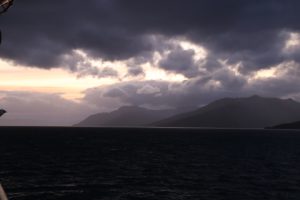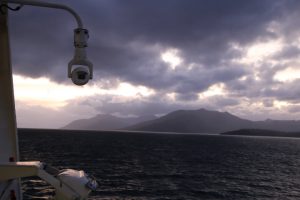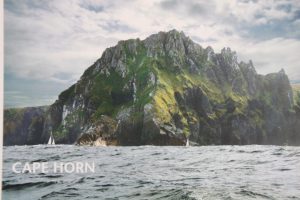After yesterday’s formal notification of the ban imposed by the Chilean authorities we had our temperatures taken to prove we are a healthy ship. As we write meetings are being held between the authorities and cruise lines.
Today we would have “rounded the Horn “. The isolated, triangular rocky island at the southernmost point of the South American continent at 55° 59´ S 67° 16´ W.
The Horn gained its fearsome reputation in the days of sail and before the opening of the Panama Canal. The book “Rounding the Horn “, Murphy D., 2005 has been an inspiration for this section of the blog.
Rounding it was considered to be a major achievement as it was the only place south of the Arctic that linked the Atlantic and Pacific Oceans.
The Cape was first rounded on 29th January 1616 by Captain Willem Schouten a Dutchman from the small port of Hoorn on the then Zuider Zee. This founded a commercial route way. Drake may have been here but only by accident. Drake reported his finding of the Cape and a possible route between the two oceans some 42 years earlier but it seems it remained secret because to Elizabeth I geographical knowledge was geopolitical power as this was ‘The Age of Discovery’ and the expansion of colonialisation. It seems that Drake or members of his crew dropped hints, possibly in a pub one night, as new ships for another mission were being built near Hoorn. Did Schouten and his crew members hear news of a route way at the bottom of the world? The Dutch East India Company was a powerful opponent in SE Asia, not only of Britain but of other Dutch traders. It might be that Isaac Le Maire, cofounder of the company, may have realised that he could prevent other Dutch traders from attacking his monopoly if no one else could use the newly found route way. He convinced the Dutch Government to grant his company exclusive rights to the Spice Island trade whether it be by the Cape of Good Hope or the then unknown to other traders, the Horn route. In other words they were locked out.
In the days of steam, cargo vessels avoided this route because of a lack of coaling and water stations. In the late 19th and early 20th centuries the Horn was the domain of fast, steel-hulled windjammers like the Peking, now displayed at the South Street seaport in New York. At this time of commercial rivalry it was agreed that ‘rounding the Horn’ was a passage from 50° S in the Atlantic to 50° S in the Pacific.
In 1905 the sailing ship ‘British Isles’ tried for 71 days to achieve a rounding. She was almost knocked flat by the mountainous seas with the yard arms reportedly touching the water. Men were washed overboard with no chance of rescue but eventually she reached Chile to unload her cargo of coal. Unfortunately she was too late to load her cargo of guano for the return trip.
This region is a product of the super continent of Pangea 180 million years ago when Antarctica became separated from South America. The exact time when this happened is difficult to prove as the geological clues are thousands of feet beneath the ice. As often happens there is an intriguing puzzle. A few decades ago in Brussels, Belgium, a 16th century map was discovered showing fields, farmland and settlements on what is thought to be Antarctica. Analysis of the paper and inks show it is definitely 16th century but is it a product of eyewitness, word of mouth or just a folly? Some geologists are convinced that it may be possible that Antarctica became detached in much more recent times because like Hawaii and Iceland it was on a ‘hot spot’ and could have just slipped away without dramatic effect and was covered by ice during more recent colder periods. The jury is still out on this but to add to the mystery NASA satellite mapping can see through the ice and seems to show those field patterns.
17:00. The best news ever! We have escaped from Punta Arenas.
“Chile has just entered a higher phase of their Coronavirus outbreak and their officials have decided to close all borders by air, land and sea as well as their airspace within the next 48 hours. We have put pressure on the authorities to allow disembarkation within the next two days, however, they are not allowing us to do this without remaining outside the city for at least 14 days”, said the Captain. We have made a run for it westwards and once in the Pacific we will head north to Valparaiso to refuel and restock but not to get off. After that we continue north but as to where we are unsure at the moment. We are currently at 54° S and our next stop is at 33° S, so we have a lot of travelling to do and lots to see.





